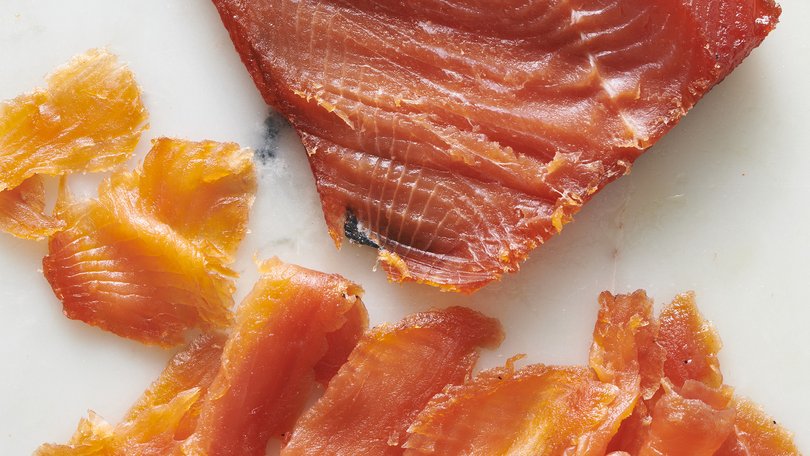This TikTok food trend is more than 10,000 years old — and Indigenous communities did it first

Somewhere along the social media food highway this past summer, there was a detour to horror.
Influencer after influencer held maple-shellacked sides of smoked salmon close to the camera, the thick slab of vermilion flesh opaque and shiny as plastic, unlike the gossamer ribbons of lox destined for bagels.
Self-described smoked salmon girlies pinched off pieces, tugging them from the skin, then took wide-eyed bites, some licking and chewing suggestively, one feeding bits to her toddler in between her own mouthfuls. Others (mostly nongirlies) grasped the fillet with both hands and pulled the meat off the skin with their teeth like a bear.
Sign up to The Nightly's newsletters.
Get the first look at the digital newspaper, curated daily stories and breaking headlines delivered to your inbox.
By continuing you agree to our Terms and Privacy Policy.It’s not that the salmon itself looked grotesque; the fish alone is mouthwatering, the tradition of smoking it beautiful.
What was horrifying to watch was the way the salmon was handled, angled so the light would glint off its heart-red sheen, its meat pulled the way zombies yank off limbs in movies.
But as a viral marketing move, it worked.
The influencers either announced that they were tasting salmon sent to them by the Idaho-based Solovey Kitchen or tagged the company, which now has longer processing times because of “the unusually high volume of orders.”
What the videos don’t delve into is the rich tradition of smoking salmon. Although Solovey Kitchen did not reply to interview requests, its social media accounts indicate that the company’s owners have roots in Slavic cuisine.
Across the Bering Strait from that region of North Asia lies present-day Alaska and, farther south, the Pacific Northwest, where Indigenous communities continue to uphold the practice of cold-smoking salmon.
Freshly caught fish is sliced off its bones, quickly wet-brined, then hung in a cold smokehouse for days over slowly smouldering alder wood that doesn’t emit heat but infuses the fish with its scent. The salmon is then preserved by drying into jerky or, in modern times, cooked and canned.
“It’s really beautiful when people take interest in trends with roots in Indigenous traditions,” said Kate Nelson, a member of the Tlingit tribe in Alaska, where her family still lives, and an author of “Turtle Island: Foods and Traditions of the Indigenous Peoples of North America.”
“Where people might take issue with it is when there isn’t context, like it’s a new phenomenon. It’s important for people to understand it: Where does this come from?”
Ms Nelson, who now lives in Minneapolis, noted that salmon is preserved in regions along northern latitudes, though not necessarily smoked, like in Scandinavia, where it is cured into gravlax.
Valerie Segrest, a Native nutritionist and the host of the podcast “The Old Growth Table,” said those connections may also come from coastal migration along the “kelp highway,” a route from Asia to the Americas rich with marine life, including salmon.
In North America, there is archaeological evidence of fisheries that date back 12,000 years at the Bear Creek Site of Redmond, Washington, Ms Segrest said.
Ms Segrest is a member of the Puget Sound’s Muckleshoot tribe, which she called “the salmon nation.” Even though tribe members no longer need to store salmon for winter in the Seattle area, they still cold-smoke salmon and pass on knowledge, like preserving late-summer coho because they’re leaner than the chinook (king) that return in spring and the sockeyes and blueblacks that arrive in June.
In southeast Alaska, Heather Douville, the host of the show “Our Way of Life,” recently finished cold-smoking and canning the coho that ran through Tlingit Aani, her tribe’s ancestral homeland. She said that, traditionally, the fish were preserved in large communal smokehouses at camps along the region’s rivers and creeks. From the 1930s to the 1960s, the Forest Service of the US Department of Agriculture destroyed them all.
“But what is a testament to our strength is that a lot of us have our personal smokehouses now at our homes,” Ms Douville said. Preserving traditional foods connects tribal members to their families, communities and homelands.
To understand the Tlingit tradition of cold-smoking salmon is to let go of modern frameworks of individuality. Preserving fish and meat arose out of a need for self-reliance, but “not by the Western definition of independence,” Ms Douville said.
“The strength is in interdependence.” In Tlingit culture, an individual uses skills and tools to take care of the community, particularly the elders.
Ms Nelson, whose family in Alaska mails her their home-smoked salmon, said that subsistence fishing and preserving the fish is necessary for food security and sovereignty, especially in more geographically isolated communities.
“Salmon isn’t just considered to be just a food, but considered a sacred being,” she said.
There is no recipe for Ms Douville’s smoked salmon, though you can watch her prepare it in a video on Meateater and on her Instagram. The method comes from knowledge passed down by elders and through practice with family that starts in childhood.
The smoke temperature is tested by feel, the salmon draped over hemlock and spruce by experience, the timing calculated not by a clock but by the number of fires burning out. The process is usually a group activity, but even if Ms Douville is the only one in the smokehouse, she experiences it communally “because you’re thinking of all the people involved: whoever shared the fish, brought the smokehouse wood.”
That sense of community can be replicated even if the act of cold-smoking can’t be.
Hank Shaw, a cookbook author also behind the site Hunter Angler Gardener Cook said: “Cold-smoking is really tricky. It’s absolutely doable, but it’s tricky.”
He has a great recipe for hot-smoking salmon, which is easier since the fish can be cooked in just a few hours on a grill at a higher temperature that can be controlled in any climate, and suggested curing the fish to achieve something more like cold-smoked salmon, which isn’t cooked in the days-long process.
My recipe cures the salmon by brining, then drying it in the refrigerator. For a hint of smokiness, I include smoked paprika and mezcal in the dry brine, heavy with brown sugar to add the natural sweet complexity that would otherwise come from cold smoking the fish.
The finished salmon can be eaten as is, but also can be steamed, poached, broiled, seared or cooked in any other way.
It’s not traditional, but it’s meant to capture something of its history and sense of community.
“I would rather have people talking about it and trying it out, even if in a modified way,” Ms Nelson said. Ms Douville thinks the same, especially in the context of social media, where she initially started posting to document traditional practices as “a positive outlet” while her father was in cancer treatment.
As her account took off, she was struck by how her representation matters.
“I want youth to go online and want them to look up things about their culture and see people like them doing the things they do,” she said, “and taking up space on social media that wasn’t necessarily made for us.”
RECIPE
Smoked Salmon Without a Smoker
Cold-smoking salmon is a time-honoured tradition in Indigenous communities in Alaska and the Pacific Northwest, as well as other cold regions where wild salmon runs. The days-long process of infusing the fish with wood smoke without heating it is a tricky one that requires a smokehouse.
To replicate the subtle smokiness and tender chew, this recipe cures the fish using a dry brine seasoned with coffee beans, smoked paprika and mezcal, ingredients that bear the scent of fire.
A fillet of uniform thickness will yield a consistent firmness, while a tapered one will have thin ends that become like jerky. If you’re concerned about uncooked salmon, you can start with flash-frozen fish, thawing it thoroughly and patting it dry before curing, or you can cook the salmon after it’s been cured.
By Genevieve Ko
Yield: 12 to 18 servings
Total time: About 3 to 4 days
3 tablespoons whole coffee beans
2 cups plus 1 tablespoon packed brown sugar, divided
2 teaspoons smoked paprika
1 cup kosher salt (such as Diamond Crystal)
1 whole (1-1.5 kilogram) side salmon fillet, preferably wild, rinsed and patted very dry
3 tablespoons mezcal
1 tablespoon maple syrup
1. Put the coffee beans on a cutting board and press a heavy skillet firmly against them to crack them each into 2 to 3 pieces. It’s OK if some remain whole. Transfer to a medium bowl and add the 2 cups brown sugar, the paprika and the salt. Stir until evenly mixed.
2. If you have a FoodSaver or Cryovac, this is the time to use it. Cut a bag a few inches longer than the length of the salmon and seal one end. Spread one-third of the sugar mixture in the bag to match the shape of the salmon and place the fish on top. Cover evenly with the rest of the salt mixture, then drizzle the mezcal on top. Suction the air out of the bag and seal. Alternatively, place two large overlapping sheets of plastic wrap on a half sheet pan. Spread one-third of the sugar over the plastic wrap, place the salmon on top and cover with the remaining sugar, then drizzle on the mezcal. Cover tightly with the plastic wrap, then wrap again in another large sheet of plastic wrap. Place on a sheet pan and weigh down the top with a large skillet.
3. Let the salmon cure in the refrigerator, turning it every 8 to 12 hours, until the thin end feels very stiff and the thick end feels very firm, 24 to 48 hours. The timing depends on the thickness of the salmon, but the flesh should feel tight when pressed.
4. Unwrap the fish and rinse it well, picking off any coffee bits. Pat is very dry. You can, at this point, thinly slice and serve the salmon like gravlax. If you prefer a firmer texture, continue by placing the fillet on a rack fitted in a sheet pan and refrigerating it uncovered for 24 to 36 hours. It needs to be uncovered so that a pellicle, or thin, shiny sheen, forms on the surface.
5. Mix the maple syrup with the remaining tablespoon of brown sugar until the sugar is almost dissolved. Brush evenly over the salmon and refrigerate for another 24 hours, brushing with any syrup that has dripped off after 12 hours.
6. The salmon should be firm and shiny. Brush it with any syrup drippings one last time, then slice at an angle, cutting the meat off from the skin to enjoy chewy slices on their own or draped over bagels with cream cheese or any other way smoked salmon would be eaten. The fish can also be steamed, poached, baked, broiled, grilled or cooked in any other way until tender and hot. Any leftover uncooked salmon can be wrapped tightly in plastic (or, ideally, vacuum sealed) and refrigerated for up to 1 week or frozen for up to 3 months.
© 2025 The New York Times Company
Originally published on The New York Times
